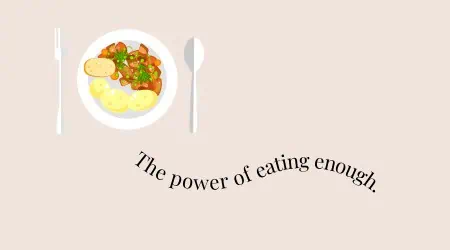
“Eat to feel good” is my advice to patients. Why? Because eating should be relaxing and create satiety, which is the feeling of being sated or full.
Achieving satiety with solid meals such as meat and potatoes is 1) a good way to achieve optimal nutrition and 2) the single best way to avoid overeating and just live your life without having to fight cravings or constantly exert willpower to avoid snacks and desserts.
Best foods for satiety
The most filling or satisfying foods are whole foods high in protein, fat, fiber, and some types of starch, such as oats and legumes. Potatoes, in particular, can be highly satiating because they provide resistant starch and a possible appetite suppressant called proteinase inhibitor 2 (PI2).
Sugar, on the other hand, is not satiating, and high-dose fructose can lead to overeating. That’s true for processed fructose like table sugar and high-fructose corn syrup. Unfortunately, that’s also true for natural sources of high-dose fructose like dates, fruit juice, and agave syrup.
Protein to feel full
According to the protein leverage hypothesis, protein is the most satiating macronutrient because protein is our primary appetite. That’s because amino acids are essential for the healthy functioning of every part of the body, including the brain, nervous system, digestive system, and more. Amino acids are so essential that we’ve evolved to just keep eating until we’ve obtained enough of them—even if that means overeating calories.
The daily requirement for protein depends on age, state of health, level of activity, and stage of life (women in menopause need more protein). Generally, you’ll need about 1 gram of protein per kilogram of ideal body weight per day. For example, if you weigh 65 kilograms and that’s your ideal weight, you need about 65 grams of protein per day, which equates to about 22 grams of high-quality protein with every meal.
What does that look like? Here’s a rough guideline of the amount of actual food you need to obtain 20 grams of protein.
| red meat | 77 grams |
| chicken breast | 87 grams |
| almonds | 93 grams |
| salmon | 105 grams |
| feta cheese | 121 grams |
| eggs | 159 grams (3 eggs) |
| tofu | 167 grams |
| chickpeas | 242 grams |
| lentils | 263 grams |
It’s like your body wakes up every morning wondering, “Am I going to obtain all the amino acids I need today?” If your goal is 65 grams, and you’re not even close to that by midday, you could start feeling hungry, distressed, and prone to snacking.
If you get all the way to evening without obtaining 65 grams, you’re likely to binge, which is eating to excess without being able to stop yourself. It’s your body saying, “Right. I need amino acids, so I have to keep eating until I get them.”
Evening binge foods could be anything, including sugar, but they’re often “protein decoy” foods, which are not protein but taste like protein thanks to their umami flavor. Chips are the best example.
The solution to evening binging is to harness protein leverage to your advantage by eating plenty of high-protein foods early in the day before you get too hungry. That means eggs, cheese, or meat by at least 12 pm and preferably by 10 am (because morning protein also helps to entrain a healthy circadian rhythm).
👉🏽 Tip: Too much protein can suppress appetite, which could be a problem if you’re in the situation of losing your period to undereating (even if you’ve been mistakenly diagnosed with PCOS).

👉🏽 Tip: There’s much more to satiety than just food. I’ll explore all the factors in my new book about metabolic health—coming in May 2024.
For an example of the power of protein, consider my patient Mandy (excerpted from my book Hormone Repair Manual).
Patient story
Mandy had struggled with weight for years, going on and off diets and always regaining it all and more. By the time she came to me, she was also seeing a psychologist for emotional eating and trying hard to eat less.
Most of Mandy’s weight was distributed around her middle in the classic apple shape that suggests insulin resistance. Her cholesterol was high, another sign of insulin resistance. I ordered a glucose tolerance test with insulin, and Mandy’s insulin results (not glucose results) were all above the normal range: 10 mIU/L (60 pmol/L) fasting, then 72 mIU/L (541 pmol/L) at the one-hour mark and 60 mIU/L (423 pmol/L) at two hours.
“You have insulin resistance,” I said, “which is prediabetes and is making you both store fat and crave sugar. The only way out of this situation is to find a way to feel a lot more satisfied with your meals so that you’ll eventually be able to quit all dessert-type foods.”
We made a plan for Mandy to start her day with coffee (which she loves) and, if she had time to prepare it, a 10 am meal of an omelette or leftover dinner. If she didn’t have time, Mandy had a quick meal of 3 eggs plus cheese or a protein smoothie. She then enjoyed two more solid meals (often meat and potatoes) for lunch and dinner and stopped eating by 7 pm, a nine-hour eating window. She also took magnesium to improve insulin sensitivity.
By the time I saw Mandy a month later, she had lost a centimetre around her waist and felt much more energetic. She had even signed up with a personal trainer. At this point, Mandy was still eating sugar because we were still at the “feeling better” part of the plan and had not yet reached the “quit dessert” part.
“I feel so much better,” Mandy told me. “You’re the first person who ever told me I could eat enough to feel good, considering how I look.”
By “considering how I look,” Mandy meant her body shape. She meant I was the first person to see her weight and still say she should eat in a way to feel good.
Mandy continued her protein breakfasts and time-restricted eating and found that, because her energy was so much better, she was eventually able to quit desserts.
When we retested her insulin six months later, all her readings were in the normal range. By that time, she had lost 10 centimetres around her waist.
Share your experience in the comments.
